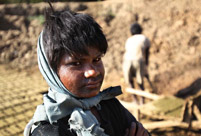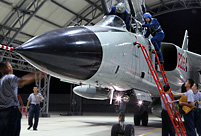TOKYO, Oct. 25 -- Japan and the United States have reaffirmed their commitment to forming a more robust military alliance in Asia, with both sides eyeing major deployments of new military hardware in the region under a mandate of a "rebalancing of power" in the area and a broader global security ideology.
The recent "two-plus-two" meetings in Tokyo between the two countries' foreign and defense chiefs saw each side give a tacit nod to bolstering military hardware in the region in a bid to augment both sides' joint military capabilities.
They have agreed that the revamped alliance between the two countries will form the basis of their military cooperation for the next two decades and comes at a time when, according to both parties, a geopolitical shift in the region necessitates certain defense protocols be revised and new hardware introduced.
In the short term, Japan will flex its military muscles in a massive exercise from Nov. 1 to 18, which will involve all of Japan's Self-Defense Forces' (SDF) units, according to defense ministry officials, and see 34,000 troops take part in the drills on and around the uninhabited islands of Okidaitojima, about 400 km southeast of the main Okinawan island.
Along with a huge contingent of military personnel, Japan will be utilizing destroyers and fighters with the purpose of the exercises being to ready Japan's forces for the advent one of its remote islands is attacked or needs to be defended, the defense ministry said, adding that the drills and the islands purportedly being defended were not aimed at any particular country or adversary.
Live-firing exercises involving destroyers will be held and F-2 fighter jets will also be weapons-ready, the ministry said, and short-range land-to-sea missiles on the island of Ishigaki, 150 km from islands at the heart of a dispute with one of Japan's neighbors, may also be deployed, local media reported.
While the defense ministry has suggested that the drills are not aimed at intimidating or provoking any of Japan's neighbors, they come at a time when Japan is in heated standoffs with some of its neighbors, including China and South Korea, over territorial disputes.
As such disputes have escalated of late, Japan's Prime Minister Shinzo Abe, since assuming office, has steadily maneuvered his defense ministry to revise its security protocols, with a U.S.- style Security Council likely to be formed before the end of this year and is seeking to, at a bare minimum, have Japan's war- renouncing Constitution reinterpreted to allow Japan's military forces more autonomy to defend what it deems to be its territories, its allies and its assets.
"There's no denying that Japan is bolstering its hardware and personnel preparedness to defend its remote territorial islands and the United States, while not overtly taking sides on issues of sovereignty, will defend Japan under the two countries' post-war bilateral agreement," political analyst and expert on territorial conflicts Teruhisa Muramatsu told Xinhua.
"For Japan, in part, it's about saber-rattling, but the sabers are very real and the hardware is cutting edge and its growing, and the troops are extremely well-disciplined and trained," Muramatsu said.
"There is a broader global security issue at hand, but essentially what we're seeing here is the United States through Japan reasserting itself in the region against certain countries it believes pose a threat to regional stability," the analyst added.
He went on to say that Japan is not just posturing, and with the United States in its court is perfectly prepared to defend itself and what it deems to be its territories with some of the most sophisticated weaponry available and this should not be taken lightly.
But, according to Muramatsu, Japan is still holding out for diplomatic talks with China and South Korea as a primary means of resolving the ongoing territorial disputes, but wishes these talks to be held without preconditions and is being fairly resolute on this matter.
He said that there should be no mistaking that Abe and his administration definitely want China and South Korea to return to the negotiating table, but intimated that ongoing military maneuvers -- including those of a constitutional nature -- may be indicative of Abe's new right-leaning, proactive regime.
While the United States has said that it hopes that all sides involved in territorial disputes can settle the issues through diplomatic channels, plans for Japan to deploy a surface-to-ship missile unit on Miyako Island in Okinawa prefecture for the first time next month, equipped with Type 88 surface-to-ship missiles capable of hitting all ships within waters between the islands, has been given a tacit nod from the United States.
Some analysts believe the barrage of new hardware being deployed in Japan can only seek to inflame current territorial standoffs, while others believe that without flexing its military muscles, Japan's neighbors may begin to doubt the country's true tenability.
According to the Centre for Global Research on Globalization, the stationing of a second X-band early warning radar in Japan near Kyoto, as part of joint anti-ballistic missile systems, are part of the Pentagon's preparations for potential conflicts in east and northeast Asia.
Meanwhile, the basing of advanced P-8 surveillance and anti- submarine planes and long-range Global Hawk drones next year, as well as the stepping up of maritime surveillance in the East China and South China Seas, may be deemed as particularly provocative moves, the research center said in a recent paper on the matter.
It added that the two squadrons of MV-22 Osprey will also enhance the capacity of the Japanese military to rapidly deploy troops in the event of a conflict on remote islands and plans to deploy F-35B stealth fighters by 2017 -- in an unprecedented move outside of the United States -- will boost Japan's ability to strike targets thousands of miles away.
"It would be wrong to assume that Japan is giving up its pacifist ways and the dawn of a new militarism is approaching under Abe, but it would be equally wrong to assume that Japan is going to bend and flex to every whim of its neighbors," Muramatsu said, adding that Japan's moves to shoot down unmanned drones encroaching in airspace over disputed islands was a testament to this.
 Low wages Indian migrant laborers
Low wages Indian migrant laborers Five fighters in flight training
Five fighters in flight training London mayor hails free trade, subway system on China tour
London mayor hails free trade, subway system on China tour Different eye catching shows at housing fairs in China
Different eye catching shows at housing fairs in China Special family portraits call attention to left-behind children
Special family portraits call attention to left-behind children Migrant children’s pain and joy in city
Migrant children’s pain and joy in city Lingerie show dazzles Wuhan Motor Show 2013
Lingerie show dazzles Wuhan Motor Show 2013  Running in fun customs at Beijing Int'l Marathon
Running in fun customs at Beijing Int'l Marathon  Weekly Sports Photos
Weekly Sports Photos Chinese riot police take Liberia peacekeeping mission
Chinese riot police take Liberia peacekeeping mission World has never been dark-- a blind kid’s life in Tibet
World has never been dark-- a blind kid’s life in Tibet Oriental education or western education?
Oriental education or western education? UNESCO world heritage site: Montale Tower
UNESCO world heritage site: Montale Tower U.S. Senate leader announces bipartisan deal
U.S. Senate leader announces bipartisan deal Chinese screen goddesses from Beijing Film Academy
Chinese screen goddesses from Beijing Film Academy Day|Week|Month